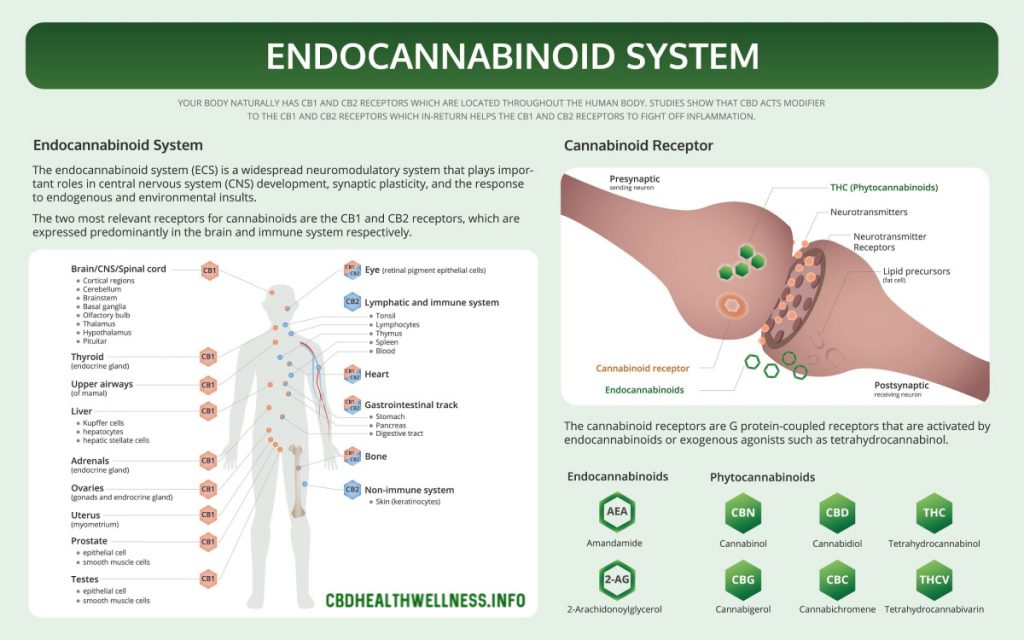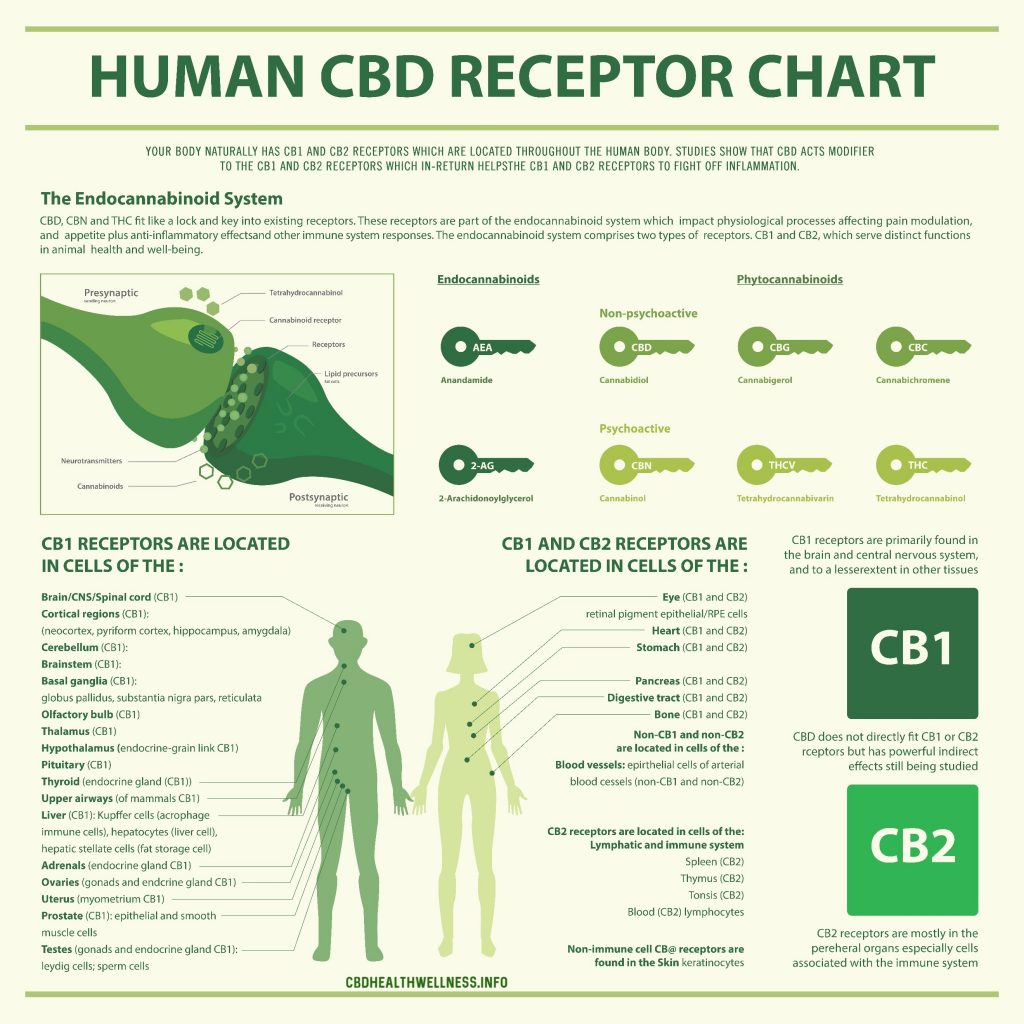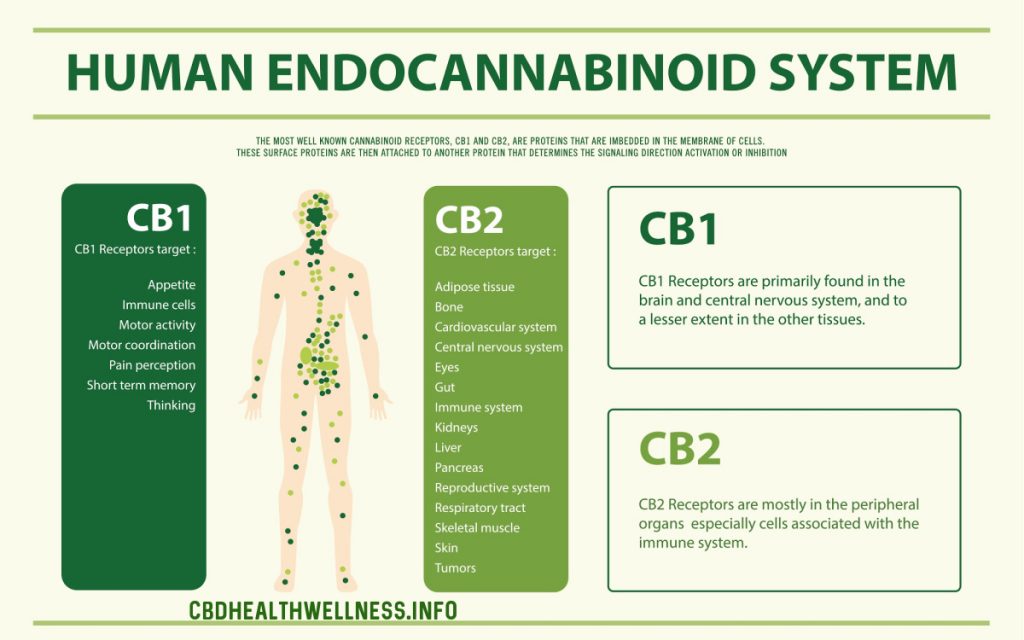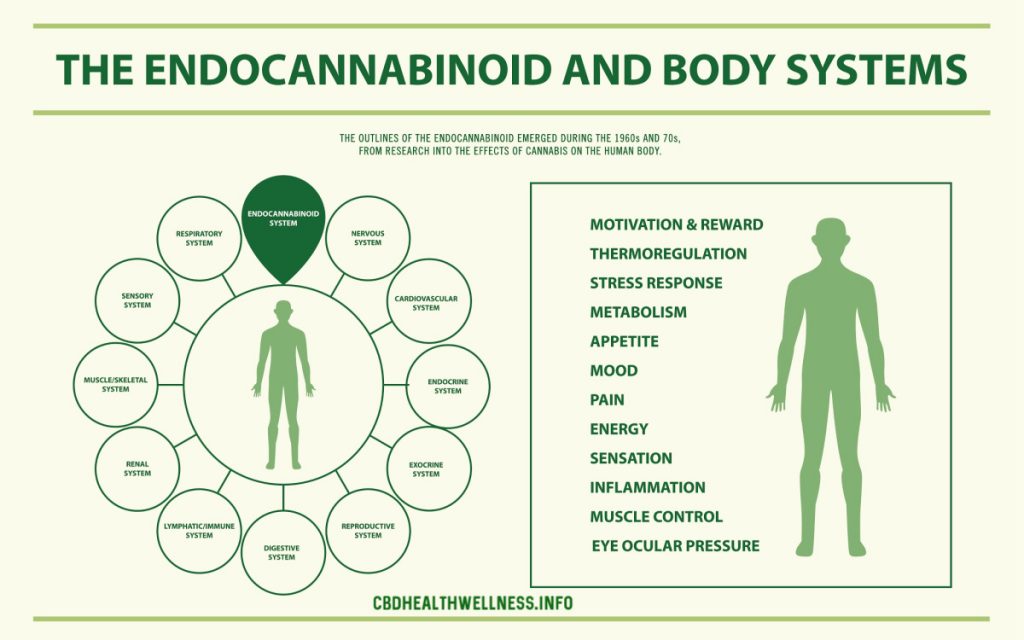
You may have noticed that people use CBD for a wide range of health concerns, including anxiety, depression, pain relief, insomnia and other sleep struggles, and digestive issues. People even give CBD to their animal companions for various ailments.
This might lead you to wonder…
Why does CBD work so well for so many different health concerns? How is this possible? How can a substance be so safe, yet so powerful?
The answer? We are hard-wired for CBD use!
To understand how CBD works in the body, let’s explore the Endocannabinoid System.
This article continues below the video and podcast.
You can also learn more about our CBD Health and Wellness podcast.
What are endocannabinoids?
In the 1990s, scientists discovered endocannabinoids, which are natural cannabis-like molecules produced by the human body. They began to realize cannabis exerted its effects, in part, by mimicking our endocannabinoids. While trying to understand the effects of the cannabis plant, they discovered a complex cell-signaling system and named it the endocannabinoid system (more on that shortly).
The word “endocannabinoid” stems from endogenous (a substance or process originating from within an organism, tissue, or cell) and cannabinoid (named for the plant, cannabis). The terms “endocannabinoid” and “endogenous cannabinoid” refer to the same thing and are used interchangeably.
It is believed that the endocannabinoid system, present in all mammals (and many other animals), evolved in primitive animals over 600 million years ago. Humans and animals naturally synthesize endocannabinoids, which are chemical compounds that activate the same receptors as delta-9-tetrahydrocannabinol (THC), the best-known active component of marijuana (Cannabis sativa).
Endocannabinoids help keep internal bodily functions running smoothly.
Several endocannabinoids have been identified so far, but the two key players are anandamide (AEA) and 2-arachidonoylglyerol (2-AG). These endocannabinoids are made from fat-like molecules within cell membranes, and are synthesized on-demand. This means that your body makes and uses them exactly when they’re needed, rather than packaged and stored for later use like many other biological molecules.
AEA and THC are similar, but AEA doesn’t get you high like THC does (CBD does not cause a “high”). AEA does have a calming effect, though. In fact, it gets its name from ananda, the Sanskrit word for bliss.
What are cannabinoids?
Cannabinoids are chemical compounds that trigger cannabinoid (and other) receptors in the body. More than 100 cannabinoids have been identified in Cannabis sativa plants (hemp and marijuana belong to this plant family). The two most commonly studied (and used) cannabinoids are cannabidiol (CBD) and tetrahydrocannabinol (THC).
It is an established scientific fact that cannabinoids and other components of cannabis can modulate many physiological systems in the human brain and body. There is a massive (and rapidly growing!) body of evidence that supports the existence of the system and the therapeutic benefits of CBD.
In the brain, cannabinoids and endocannabinoids work as neurotransmitters (chemical messengers that deliver information from one cell to the next.) Neurotransmitters all interact with a lot of different receptors and thus have a lot of different effects.
Experts aren’t completely sure how CBD interacts with the ECS. But they do know that it doesn’t bind to CB1 or CB2 receptors the way THC does. Instead, many believe it works by preventing endocannabinoids from being broken down. This allows them to have more of an effect on your body. Others believe that CBD binds to a receptor that hasn’t been discovered yet. We will discuss receptors in more detail shortly.
What is the Endocannabinoid System?
The endocannabinoid system (ECS) is a biological system which plays many important roles in the human body. It is responsible for the physical and psychological effects of cannabis.
Endocannabinoids and their receptors are found throughout the body. In each tissue, the cannabinoid system performs different tasks, but the goal is always the same: homeostasis, the maintenance of a stable internal environment despite fluctuations in the external environment.
In the introduction to Getting High on the Endocannabinoid System, Dr. Bradley Alger eloquently described the ECS:
The endogenous cannabinoid system—named for the plant that led to its discovery—is one of the most important physiologic systems involved in establishing and maintaining human health. Endocannabinoids and their receptors are found throughout the body: in the brain, organs, connective tissues, glands, and immune cells. With its complex actions in our immune system, nervous system, and virtually all of the body’s organs, the endocannabinoids are literally a bridge between body and mind. By understanding this system, we begin to see a mechanism that could connect brain activity and states of physical health and disease.
The ECS exists and is active in your body even if you don’t use cannabis. Its functioning depends on many factors, including genetics, age, stress levels, diet, and overall level of health.
Not only is the ECS a natural bodily system – it’s a very important one. You may have heard a lot of claims about the medicinal properties of marijuana or about THC and CBD. Some of those claims may seem to be too good to be true, but research supports many of them. The reason for the far-reaching effects have to do with the wonders of the endocannabinoid system itself.
As Dr. Dustin Sulak explains in The Endocannabinoid System,
Cannabinoids promote homeostasis at every level of biological life, from the sub-cellular, to the organism, and perhaps to the community and beyond. Here’s one example: autophagy, a process in which a cell sequesters part of its contents to be self-digested and recycled, is mediated by the cannabinoid system. While this process keeps normal cells alive, allowing them to maintain a balance between the synthesis, degradation, and subsequent recycling of cellular products, it has a deadly effect on malignant tumor cells, causing them to consume themselves in a programmed cellular suicide. The death of cancer cells, of course, promotes homeostasis and survival at the level of the entire organism.
Endocannabinoids and cannabinoids are also found at the intersection of the body’s various systems, allowing communication and coordination between different cell types. At the site of an injury, for example, cannabinoids can be found decreasing the release of activators and sensitizers from the injured tissue, stabilizing the nerve cell to prevent excessive firing, and calming nearby immune cells to prevent release of pro-inflammatory substances. Three different mechanisms of action on three different cell types for a single purpose: minimize the pain and damage caused by the injury.
The presence and critical functions of the ECS across many systems of the body, including the nervous and immune systems, explains why such a wide variety of ailments and disease states are responsive to cannabis-based interventions – including the use of CBD.
The three main components of the ECS are:
- Endocannabinoids, small molecules that activate cannabinoid receptors
- Cannabinoid receptors, which are located in the nervous system and throughout the body – endocannabinoids and cannabinoids bond with them
- Enzymes that help break down endocannabinoids and cannabinoids after they are used
These functions all contribute to homeostasis, which refers to the stability of your internal environment. For example, if an outside force, such as pain from an injury or a fever, throws off your body’s homeostasis, your ECS kicks in to help your body return to its ideal operation.
What are cannabinoid receptors?
Cannabinoid receptors sit on the surface of cells and “listen” to conditions outside the cell. They transmit information about changing conditions to the inside of the cell, jump-starting the appropriate cellular response.
We have (at least) two types of cannabinoid receptors:
- CB1 – in the central nervous system (brain and nerves of the spinal cord)
- CB2 – in the peripheral nervous system (nerves in your extremities), the digestive system, and specialized cells in the immune system

Cannabinoid receptors are believed to be among the most plentiful in our central nervous system, and some researchers hypothesize that we could have a third, undiscovered one, as well.
CB1 and CB2 are expressed in mammals, birds, reptiles, and fish.
Endocannabinoids can bind to either receptor. The effects that result depend on where the receptor is located and which endocannabinoid it binds to.
For example, endocannabinoids might target CB1 receptors in a spinal nerve to relieve pain. Others might bind to a CB2 receptor in your immune cells to signal that your body’s experiencing inflammation, a common sign of autoimmune disorders.

Initially, research suggested endocannabinoid receptors were only present in the brain and nerves, but scientists later found that the receptors are present throughout the body, including our skin, immune cells, bone, fat tissue, liver, pancreas, skeletal muscle, heart, blood vessels, kidney, and gastrointestinal tract.
Through those receptors, the ECS helps regulate a lot of important functions, such as:
- appetite and digestion
- metabolism
- immune function
- chronic pain
- inflammation
- mood
- sleep
- reproduction/fertility
- motor control
- temperature regulation
- memory and learning
- cardiovascular functioning
- muscle formation
- bone health
- liver function
- pleasure/reward
- stress
- skin and nerve function
What role do enzymes play?
When endocannabinoids have finished their job and brought things into balance within the body, certain enzymes come along to break them down and prevent them from going too far and upsetting the balance in the opposite direction.
The two main enzymes that are responsible for breaking down endocannabinoids once they’ve carried out their functions are:
- fatty acid amide hydrolase (FAAH), which breaks down AEA
- monoacylglycerol acid lipase (MAGL), which breaks down 2-AG
These enzymes ensure that endocannabinoids get used when they’re needed, but not for longer than necessary. This distinguishes endocannabinoids from many other molecular signals in the body, such as hormones or classical neurotransmitters, which can persist for many seconds or minutes, or get packaged and stored for later use.
CBD can affect overall levels of endocannabinoids in the brain, referred to as “endocannabinoid tone.” CBD inhibits the FAAH enzyme, which as explained above, breaks down anandamide. This means CBD can increase anandamide levels by preventing FAAH from breaking it down. Inhibiting the FAAH enzyme has been shown to be a useful strategy for treating anxiety disorders – some of CBD’s anti-anxiety properties may come from its ability to inhibit this enzyme, in other words.
What is Clinical Endocannabinoid Deficiency?
When the ECS becomes dysregulated, this is called clinical endocannabinoid deficiency. Experts believe this dysfunction is likely implicated in nearly all disease conditions.
According to U.S. National Institutes of Health scientists Pal Pacher and George Kunos, “Modulating endocannabinoid system activity may have therapeutic potential in almost all diseases affecting humans, including obesity/metabolic syndrome, diabetes and diabetic complications, neurodegenerative, inflammatory, cardiovascular, liver, gastrointestinal, skin diseases, pain, psychiatric disorders, cachexia, cancer, chemotherapy-induced nausea and vomiting among many others.”
Project CBD elaborates:
When the endocannabinoid system doesn’t function properly, our health suffers.
By modulating the endocannabinoid system and improving endocannabinoid tone, CBD and THC can slow, or in some cases stop, the progression of various diseases.
Dr. Ethan Russo, a board-certified neurologist and psychopharmacology researcher, believes that many chronic diseases may be caused by clinical endocannabinoid deficiency. In an interview with Project CBD, Dr. Russo explained what a deficiency of endocannabinoid function might look like:
If you don’t have enough endocannabinoids you have pain where there shouldn’t be pain. You would be sick, meaning nauseated. You would have a lowered seizure threshold. And just a whole litany of other problems. It occurred to me that a number of very common diseases seem to fit a pattern that would be consistent with an endocannabinoid deficiency, specially these are migraine, irritable bowel syndrome, and fibromyalgia. They have some things in common. They’re all hyper-algesic syndromes, meaning that there’s seems to be pain out of proportion to what should be going on, in other words you can look at the tissues they look okay, but there’s biochemically something that’s driving the pain. (source)
To read Dr. Russo’s 2016 paper on endocannabinoid deficiency, please click here: Clinical Endocannabinoid Deficiency Reconsidered: Current Research Supports the Theory in Migraine, Fibromyalgia, Irritable Bowel, and Other Treatment-Resistant Syndromes
Which conditions may cannabinoids help?
Cannabinoids are being researched as potential treatments for all kinds of conditions, not just those involving endocannabinoid deficiency. Many studies have already revealed that CBD may be therapeutic for many conditions, including but not limited to:
- Alzheimer’s disease
- addiction and alcoholism
- anxiety
- cancer
- cardiovascular disease
- diabetes
- depression
- digestive issues
- epilepsy and seizure disorders
- insomnia and sleep disorders
- neurological, neurodegenerative, neurodevelopmental, and psychiatric illnesses
- acute and chronic kidney disease
- autoimmune diseases
- chronic inflammatory diseases
- chronic pain conditions

So, there you have it! I hope this article clears up any questions you have about the endocannabinoid system and how CBD works. If you have additional questions, please feel free to reach out to us using this form: Contact Us
Good explanation of the ECS. I have toured the west coast from Mexico to Canada, then into Colorado mainly questioning everyone from Drs to bud tenders to patients about medical cannabis containing THC. This took over a year and was before the CBD crase hit, but along this journey I kept herring more and more about the wonders of CBD and have been looking into it since returning home from Colorado in November of 14. I currently use a sativa dominate cannabis during the day and load up on CBD hemp flower at night. I’m 63 with chronic pain and other conditions that this combination treats very well.
Thank you for your hard work
Stephen Riner, RN (retired)